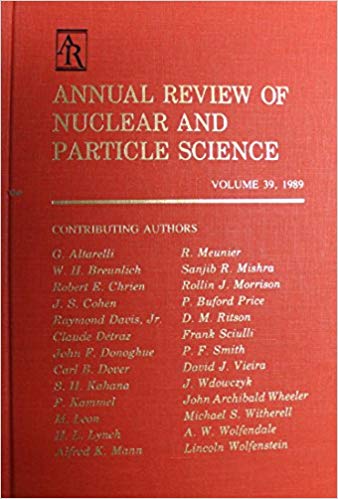The Hubble Tension and Early Dark Energy
IF 9.1
2区 物理与天体物理
Q1 PHYSICS, NUCLEAR
Annual Review of Nuclear and Particle Science
Pub Date : 2022-11-08
DOI:10.1146/annurev-nucl-111422-024107
引用次数: 50
Abstract
Over the past decade, the disparity between the value of the cosmic expansion rate determined directly from measurements of distance and redshift and that determined instead from the standard Lambda cold dark matter (ΛCDM) cosmological model, calibrated by measurements from the early Universe, has grown to a level of significance requiring a solution. Proposed systematic errors are not supported by the breadth of available data (and unknown errors untestable by lack of definition). Simple theoretical explanations for this Hubble tension that are consistent with the majority of the data have been surprisingly hard to come by, but in recent years, attention has focused increasingly on models that alter the early or pre-recombination physics of ΛCDM as the most feasible. Here, we describe the nature of this tension and emphasize recent developments on the observational side. We then explain why early-Universe solutions are currently favored and the constraints that any such model must satisfy. We discuss one workable example, early dark energy, and describe how it can be tested with future measurements. Given an assortment of more extended recent reviews on specific aspects of the problem, the discussion is intended to be fairly general and understandable to a broad audience. Expected final online publication date for the Annual Review of Nuclear and Particle Science, Volume 73 is September 2023. Please see http://www.annualreviews.org/page/journal/pubdates for revised estimates.哈勃张力与早期暗能量
在过去的十年里,直接通过距离和红移测量确定的宇宙膨胀率值与通过早期宇宙测量校准的标准Lambda冷暗物质(∧CDM)宇宙学模型确定的宇宙扩张率值之间的差异已经发展到需要解决的重要程度。现有数据的广度不支持所提出的系统性错误(以及由于缺乏定义而无法确定的未知错误)。与大多数数据一致的哈勃张力的简单理论解释令人惊讶地难以获得,但近年来,人们越来越关注将∧CDM的早期或预复合物理改变为最可行的模型。在这里,我们描述了这种紧张局势的性质,并强调了观测方面的最新进展。然后,我们解释了为什么早期的宇宙解决方案目前受到青睐,以及任何此类模型必须满足的约束。我们讨论了一个可行的例子,早期暗能量,并描述了如何通过未来的测量来测试它。考虑到最近对该问题具体方面的各种更广泛的评论,讨论旨在相当一般,并为广大观众所理解。《核与粒子科学年度评论》第73卷预计最终在线出版日期为2023年9月。请参阅http://www.annualreviews.org/page/journal/pubdates用于修订估算。
本文章由计算机程序翻译,如有差异,请以英文原文为准。
求助全文
约1分钟内获得全文
求助全文
来源期刊
CiteScore
21.50
自引率
0.80%
发文量
18
期刊介绍:
The Annual Review of Nuclear and Particle Science is a publication that has been available since 1952. It focuses on various aspects of nuclear and particle science, including both theoretical and experimental developments. The journal covers topics such as nuclear structure, heavy ion interactions, oscillations observed in solar and atmospheric neutrinos, the physics of heavy quarks, the impact of particle and nuclear physics on astroparticle physics, and recent advancements in accelerator design and instrumentation.
One significant recent change in the journal is the conversion of its current volume from gated to open access. This conversion was made possible through Annual Reviews' Subscribe to Open program. As a result, all articles published in the current volume are now freely available to the public under a CC BY license. This change allows for greater accessibility and dissemination of research in the field of nuclear and particle science.

 求助内容:
求助内容: 应助结果提醒方式:
应助结果提醒方式:


